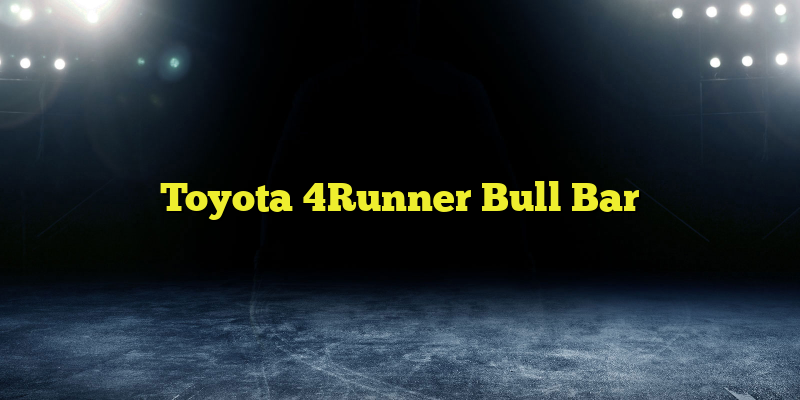A Toyota 4Runner Bull Bar is a popular accessory for owners who want to enhance the look and protection of their vehicles. Whether you use your 4Runner for off-roading adventures or daily commuting, a bull bar can provide several benefits. In this article, we will discuss the importance of a bull bar, its different types, installation process, and some frequently asked questions about Toyota 4Runner bull bars.
Why Choose a Bull Bar for Your Toyota 4Runner?
A bull bar is a sturdy metal bar that is installed on the front end of a vehicle. It serves as a robust protective shield, guarding the front of the vehicle from potential damage caused by collisions with animals, debris, or other vehicles. Here are some key reasons why you should consider adding a bull bar to your Toyota 4Runner:
- Enhanced Protection: A bull bar provides an extra layer of protection to the front end of your vehicle, minimizing the risk of damage to the radiator, headlights, and other vital components in case of an accident.
- Off-Road Readiness: If you frequently take your 4Runner off-road, a bull bar can protect the front end from branches, rocks, and other obstacles that may cause dents or scratches.
- Stylish Appearance: Bull bars come in various designs and finishes, allowing you to customize the look of your Toyota 4Runner according to your preferences. It adds a rugged and aggressive look to the vehicle.
- Mounting Space: Some bull bars are equipped with mounting tabs or light bars, providing additional space to mount auxiliary lights or accessories such as winches, antennas, or light bars.
Types of Bull Bars for Toyota 4Runner
When it comes to bull bars for Toyota 4Runner, there are generally three main types to choose from:
- Full Bull Bar: A full bull bar provides complete coverage and protection to the front end of the vehicle, extending from one side of the front fender to the other. It offers the highest level of protection but may add more weight to the vehicle.
- Loop Bull Bar: Loop bull bars have a loop-shaped design that offers protection to the front grille and headlights. They are lighter than full bull bars and provide a sleek and stylish look to the vehicle.
- Skid Plate Bull Bar: Skid plate bull bars are designed with an additional skid plate that offers protection to the underside of the vehicle. They are ideal for off-roading and provide comprehensive protection against rocks and rough terrains.
Installation Process
While it is recommended to have a professional install your Toyota 4Runner bull bar, some enthusiasts prefer to take on the task themselves. Here are the general steps involved in the installation process:
- Gather the tools: Before you begin, make sure you have all the necessary tools such as a wrench, socket set, drill, and mounting hardware provided with the bull bar.
- Prepare the vehicle: Park your 4Runner on a flat surface and disconnect the battery to avoid any electrical mishaps during the installation process.
- Remove the front bumper: Depending on the bull bar design, you may need to remove the front bumper to access the mounting points.
- Mount the bull bar: Align the bull bar with the mounting points and secure it using the provided hardware. Make sure the bull bar is level and properly tightened to ensure a secure fit.
- Reinstall the front bumper: If you had to remove the front bumper, reinstall it carefully and ensure all the clips and screws are properly secured.
- Test and make adjustments: Once the bull bar is installed, test it by gently pushing on it to check for any movement or misalignment. Make any necessary adjustments to ensure a proper fit.
It is important to note that the installation process may vary depending on the specific bull bar and vehicle model. Therefore, it is always recommended to refer to the manufacturer’s instructions or seek professional installation if you are unsure.
Frequently Asked Questions about Toyota 4Runner Bull Bars
Are bull bars legal?
Yes, bull bars are legal in most regions. However, it is important to check the local regulations and laws regarding the use of bull bars to ensure compliance. Some jurisdictions may have specific requirements regarding the design and installation of bull bars.
Do bull bars affect vehicle safety?
When installed properly, bull bars can enhance vehicle safety by providing additional protection to the front end. However, it is essential to choose a bull bar that is compatible with your vehicle’s safety features such as airbags and sensors. Improperly installed or incompatible bull bars may interfere with these safety systems and compromise their effectiveness.
Can I install a bull bar myself?
While it is possible to install a bull bar yourself, it is recommended to have it installed by a professional. This ensures proper alignment, fitment, and avoids any potential damage to the vehicle during the installation process. Additionally, professional installation may be required to maintain the vehicle’s warranty.
